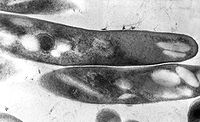
Engineering the Cell Envelope of Gram-Negative Bacteria
Sign Up to like & getrecommendations! Published in 2017 at "Biophysical Journal"
DOI: 10.1016/j.bpj.2016.11.1675
Abstract: The cell envelope in Gram-negative bacteria is made of two distinct membranes and a cell wall between them. Although there is growing interest in the mechanical adaptation of this cell envelope to turgor pressure, how… read more here.
Keywords: cell envelope; gram negative; envelope gram; negative bacteria ... See more keywords

A novel bacteriocin BMP11 and its antibacterial mechanism on cell envelope of Listeria monocytogenes and Cronobacter sakazakii
Sign Up to like & getrecommendations! Published in 2018 at "Food Control"
DOI: 10.1016/j.foodcont.2018.03.038
Abstract: Abstract Listeria monocytogenes and Cronobacter sakazakii are notorious pathogens involved in numerous foodborne outbreaks after ingested contaminated food. Bacteriocins are natural food preservatives, some of which have antimicrobial activity comparable with antibiotics. In this study,… read more here.
Keywords: bmp11; cell envelope; monocytogenes cronobacter; cronobacter sakazakii ... See more keywords

Natural products that target the cell envelope.
Sign Up to like & getrecommendations! Published in 2021 at "Current opinion in microbiology"
DOI: 10.1016/j.mib.2021.02.001
Abstract: The inexorable spread of resistance to clinically used drugs demands that we maintain a full pipeline of antibiotic candidates. As organisms have struggled to survive and compete over evolutionary history, they have developed the capacity… read more here.
Keywords: cell envelope; natural products; target cell; products target ... See more keywords

A Delicate Connection: c-di-AMP Affects Cell Integrity by Controlling Osmolyte Transport.
Sign Up to like & getrecommendations! Published in 2018 at "Trends in microbiology"
DOI: 10.1016/j.tim.2017.09.003
Abstract: Bacteria use second-messenger molecules to adapt to their environment. Several second messengers, among them cyclic di-AMP (c-di-AMP), have been discovered and intensively studied. Interestingly, c-di-AMP is essential for growth of Gram-positive bacteria such as Bacillus… read more here.
Keywords: delicate connection; cell envelope; amp; amp metabolism ... See more keywords

Cell Envelope Proteomics of Mycobacteria.
Sign Up to like & getrecommendations! Published in 2020 at "Journal of proteome research"
DOI: 10.1021/acs.jproteome.0c00650
Abstract: The World Health Organization (WHO) estimates that Mycobacterium tuberculosis, the most pathogenic mycobacterium species to humans, has infected up to a quarter of the world's population, with the occurrence of multidrug-resistant strains on the rise.… read more here.
Keywords: envelope proteomics; proteomics mycobacteria; cell; cell envelope ... See more keywords

A Bifunctional Chemical Reporter for in Situ Analysis of Cell Envelope Glycan Recycling in Mycobacteria.
Sign Up to like & getrecommendations! Published in 2022 at "ACS infectious diseases"
DOI: 10.1021/acsinfecdis.2c00396
Abstract: In mycobacteria, the glucose-based disaccharide trehalose cycles between the cytoplasm, where it is a stress protectant and carbon source, and the cell envelope, where it is released as a byproduct of outer mycomembrane glycan biosynthesis… read more here.
Keywords: cell; situ; bifunctional chemical; cell envelope ... See more keywords

In Vitro Model of the Gram-Negative Bacterial Cell Envelope for Investigation of Anti-Infective Permeation Kinetics.
Sign Up to like & getrecommendations! Published in 2018 at "ACS infectious diseases"
DOI: 10.1021/acsinfecdis.7b00165
Abstract: The cell envelope of Gram-negative bacteria is a formidable biological barrier, inhibiting the action of antibiotics by impeding their permeation into the intracellular environment. In-depth understanding of permeation through this barrier remains a challenge, despite… read more here.
Keywords: cell envelope; gram negative; permeation; anti infective ... See more keywords

Global landscape of cell envelope protein complexes in Escherichia coli
Sign Up to like & getrecommendations! Published in 2018 at "Nature Biotechnology"
DOI: 10.1038/nbt.4024
Abstract: Bacterial cell envelope protein (CEP) complexes mediate a range of processes, including membrane assembly, antibiotic resistance and metabolic coordination. However, only limited characterization of relevant macromolecules has been reported to date. Here we present a… read more here.
Keywords: escherichia coli; cell; cell envelope; envelope protein ... See more keywords

Glycolytic reprograming in Salmonella counters NOX2-mediated dissipation of ΔpH
Sign Up to like & getrecommendations! Published in 2020 at "Nature Communications"
DOI: 10.1038/s41467-020-15604-2
Abstract: The microbial adaptations to the respiratory burst remain poorly understood, and establishing how the NADPH oxidase (NOX2) kills microbes has proven elusive. Here we demonstrate that NOX2 collapses the ΔpH of intracellular Salmonella Typhimurium. The… read more here.
Keywords: glycolytic reprograming; cell envelope; salmonella; reprograming salmonella ... See more keywords

Intermembrane transport: Glycerophospholipid homeostasis of the Gram-negative cell envelope
Sign Up to like & getrecommendations! Published in 2019 at "Proceedings of the National Academy of Sciences of the United States of America"
DOI: 10.1073/pnas.1902026116
Abstract: This perspective addresses recent advances in lipid transport across the Gram-negative inner and outer membranes. While we include a summary of previously existing literature regarding this topic, we focus on the maintenance of lipid asymmetry… read more here.
Keywords: gram negative; transport; cell envelope; lipid transport ... See more keywords

The Wsp system of Pseudomonas aeruginosa links surface sensing and cell envelope stress
Sign Up to like & getrecommendations! Published in 2022 at "Proceedings of the National Academy of Sciences of the United States of America"
DOI: 10.1073/pnas.2117633119
Abstract: Significance Bacteria must respond quickly to environmental changes to survive. One way bacteria can respond to environmental stress is by undergoing a lifestyle transition from individual, free-swimming cells to a surface-associated community called a biofilm… read more here.
Keywords: stress; envelope stress; pseudomonas aeruginosa; wsp system ... See more keywords